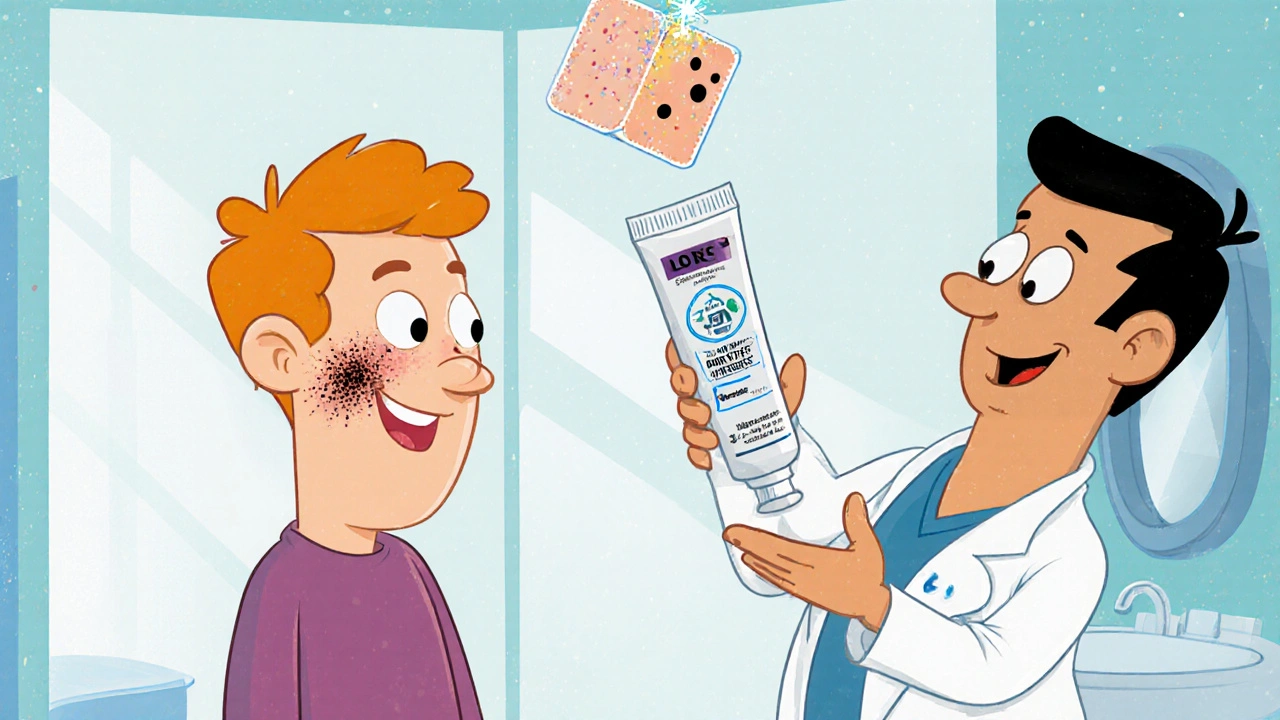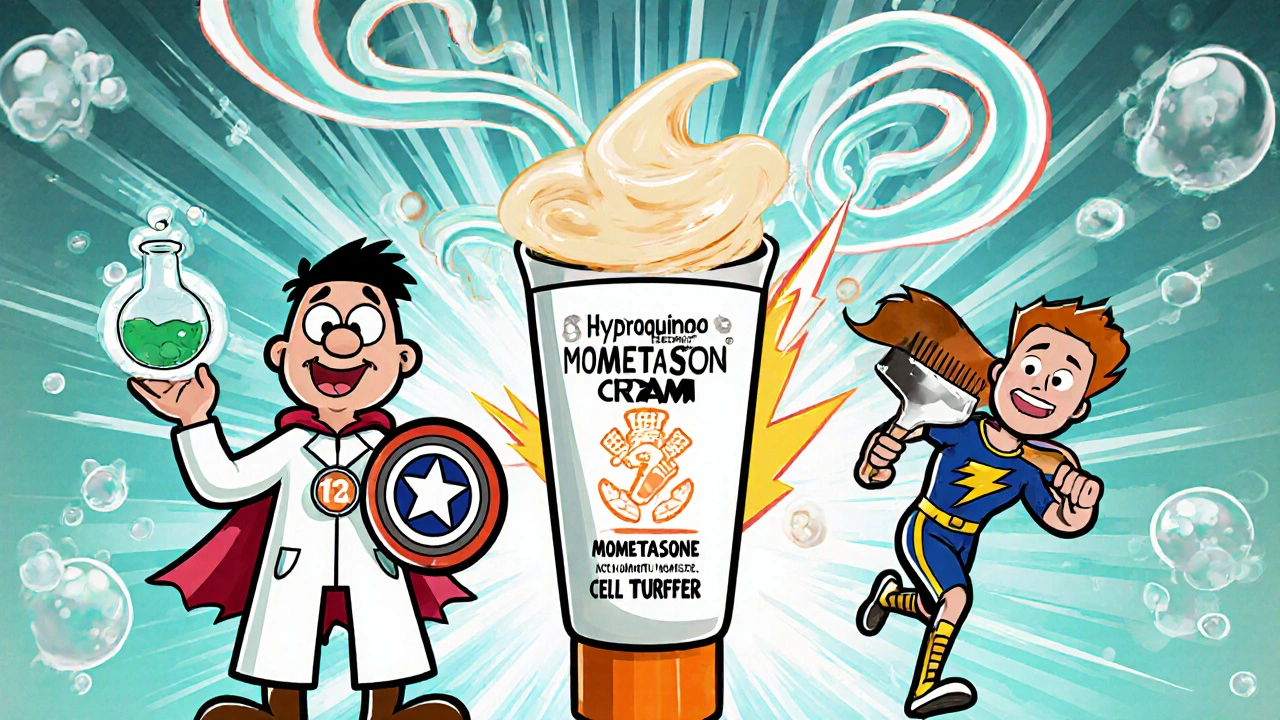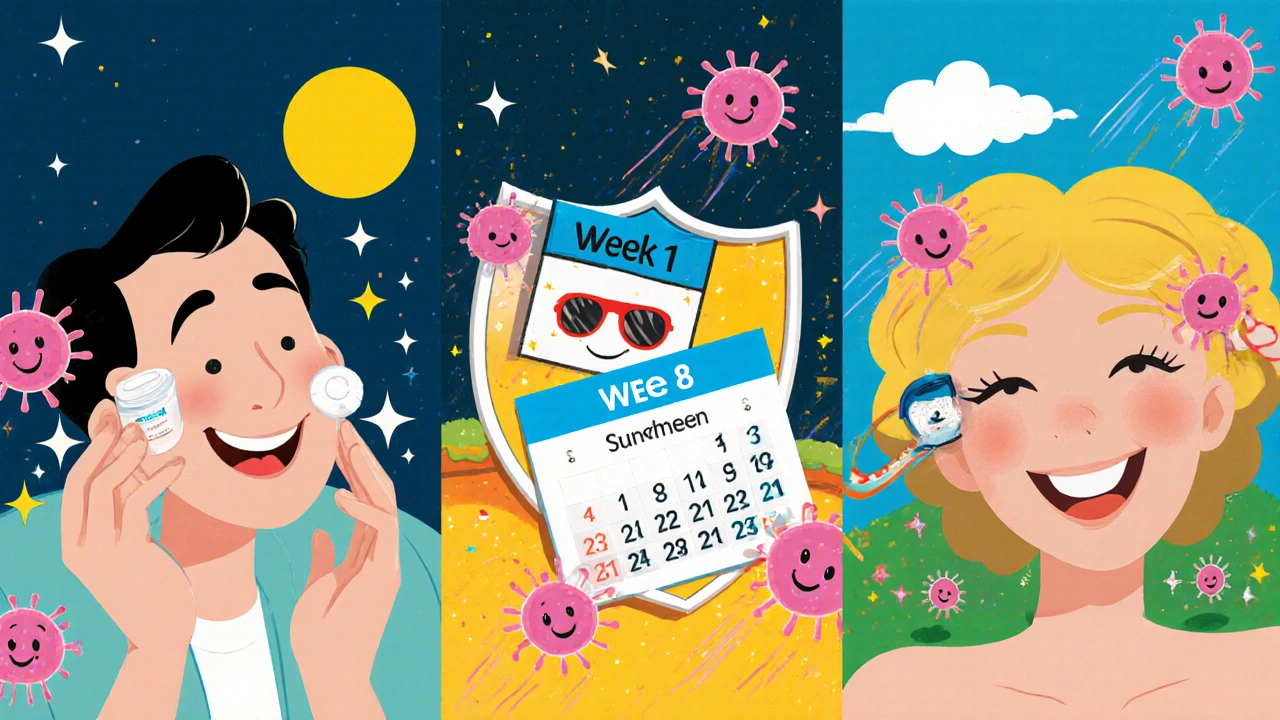Hydroquinone, Mometasone & Tretinoin Cream: Fast Fix for Dark Spots
 Oct, 15 2025
Oct, 15 2025
Hyperpigmentation Treatment Timeline Calculator
Personalize Your Treatment Plan
Treatment Timeline Overview
Apply nightly after cleansing, morning sunscreen
Possible initial improvement, may see mild peeling
Noticeable fading of dark spots, especially with high adherence
Optimal results, maintenance phase begins
Critical Sun Protection Reminder
Skipping sunscreen is the most common reason patients lose progress or develop new spots. Your results will be significantly impacted if you don't use at least SPF 30 daily with reapplication every 2 hours outdoors.
Expected Results Timeline
Your personalized timeline will appear here based on your selections.
When stubborn dark spots refuse to fade, many turn to prescription blends that combine a lightening agent, a steroid, and a retinoid. The trio-hydroquinone, mometasone, and tretinoin-has become a go‑to solution for melasma, post‑inflammatory hyperpigmentation, and uneven skin tone. Below you’ll find a plain‑language breakdown of how each ingredient works, when the combo is right for you, and what to watch out for.
Quick Takeaways
- The combination targets melanin production, inflammation, and skin turnover in one regimen.
- Effective results typically appear in 4‑8 weeks, but strict sun protection is non‑negotiable.
- Potential side effects include irritation, steroid‑related thinning, and rare ochronosis.
- Consult a qualified dermatologist before starting.
- Alternatives like azelaic acid or kojic acid may suit sensitive skin better.
What Is Hydroquinonemometasonetretinoin?
Hydroquinonemometasonetretinoin is a prescription‑strength cream that blends three active ingredients: hydroquinone, mometasone, and tretinoin. Together they address the three main drivers of hyperpigmentation: excess melanin, inflammation, and slow cell turnover.
How Each Component Works
- Hydroquinone - Often called the gold standard for skin lightening, hydroquinone inhibits the enzyme tyrosinase, which is essential for melanin synthesis. Typical concentrations range from 2% (over‑the‑counter) to 4% (prescription).
- Mometasone - This medium‑potency corticosteroid reduces the inflammatory cascade that can amplify pigment production. It also helps minimize the irritation hydroquinone can cause.
- Tretinoin - As a retinoic acid, tretinoin accelerates epidermal turnover, shedding pigmented cells faster and promoting collagen synthesis for smoother texture.
By hitting all three targets, the combination can produce faster and more uniform fading than any single agent alone.
When to Use This Triple Therapy
The blend is most appropriate for:
- Melasma that resists standard hydroquinone alone.
- Post‑inflammatory hyperpigmentation after acne, eczema, or laser procedures.
- Diffuse uneven skin tone where multiple factors are at play.
It’s not recommended for:
- Pregnant or breastfeeding individuals (hydroquinone is contraindicated).
- People with a history of steroid‑induced skin atrophy.
- Very sensitive skin that reacts strongly to retinoids.

Application Protocol
- Cleanse gently with a pH‑balanced cleanser; pat dry.
- Apply a pea‑size amount to the affected area once nightly, preferably after a short waiting period following any other serums.
- Follow with a broad‑spectrum sunscreen (SPF30+), reapplying every two hours when outdoors.
- Continue for 4‑8 weeks, then taper: reduce to every other night for two weeks, then stop if results are satisfactory.
Skipping sunscreen is the most common reason patients lose progress or develop new spots.
Potential Side Effects & How to Manage Them
Because three potent agents are involved, monitoring is key.
- Transient irritation: redness, mild peeling, or a burning sensation. Mitigate with a moisturizer containing ceramides or hyaluronic acid.
- Steroid‑related thinning: if you notice skin becoming fragile, limit use to 2‑3 nights per week after the initial 4‑week phase.
- Exogenous ochronosis: a rare, permanent bluish‑gray discoloration linked to prolonged high‑dose hydroquinone. Use the lowest effective concentration and avoid use beyond 12 weeks without a break.
If any side effect worsens, pause treatment and consult your dermatologist.
Comparing Alternatives
| Product | Primary Action | Typical Concentration | Pros | Cons |
|---|---|---|---|---|
| Hydroquinonemometasonetretinoin | Melanin inhibition + anti‑inflammation + cell turnover | 4% hydroquinone / 0.1% mometasone / 0.025% tretinoin | Fast, comprehensive results; works for stubborn melasma | Requires prescription; risk of irritation and steroid side effects |
| Azelaic Acid | Tyrosinase inhibition + anti‑bacterial | 15‑20% | Gentle, suitable for sensitive skin, also treats rosacea | Slower results; may cause mild tingling |
| Kojic Acid | Melanin synthesis blocker | 1‑4% | Natural origin, good for lightening post‑acne marks | Potential allergen; less potent than hydroquinone |
| Glycolic Acid | Exfoliation (AHA) | 5‑10% | Improves texture, boosts other agents' penetration | Can cause photosensitivity; not a primary melanin inhibitor |
Choosing the right option depends on your skin’s tolerance, the depth of discoloration, and whether you need a prescription‑only solution.

Key Supporting Practices
- Sunscreen: Use a mineral or broad‑spectrum chemical sunscreen with at least SPF30 every morning, reapplying throughout the day. \n
- Barrier Repair: Incorporate a gentle ceramide‑rich moisturizer to offset dryness from tretinoin.
- Patch Test: Apply a small amount on the inner forearm for three days before full‑face use.
- Regular Follow‑Up: Schedule a check‑in with your dermatologist every 4‑6 weeks to assess progress and adjust dosage.
Frequently Asked Questions
How long does it take to see results?
Most patients notice a visible lightening after 4‑6 weeks, with optimal results by 8‑12 weeks, provided they maintain daily sunscreen.
Can I use this cream with other actives like vitamin C?
It’s safest to separate vitamin C and tretinoin by at least 30 minutes, or use vitamin C in the morning and the combination cream at night.
Is there a risk of skin discoloration after stopping?
If you discontinue without maintaining sun protection, new spots can form. A maintenance regimen with a lower‑strength hydroquinone or a gentler agent helps prevent recurrence.
Can pregnant women use this treatment?
No. Hydroquinone is classified as Category C for pregnancy, and safer alternatives should be chosen.
What should I do if I develop a rash?
Stop using the product immediately, rinse with cool water, apply a fragrance‑free barrier cream, and schedule an urgent visit with your dermatologist.
Bottom Line
The hydroquinone‑mometasone‑tretinoin blend offers a potent, triple‑action approach for stubborn dark spots and uneven tone. Success hinges on disciplined application, rigorous sun protection, and professional oversight. If you’re dealing with persistent melasma or post‑inflammatory marks and have tried single agents without luck, this combination may be worth a conversation with your dermatologist.
Iain Clarke
October 15, 2025 AT 13:13This triple‑action cream packs a lot of science into a tiny tube. Hydroquinone tackles melanin production, mometasone calms the inflammation, and tretinoin speeds up cell turnover. When used together they can shave weeks off the usual fading timeline, but the trade‑off is a stricter regimen. Consistent broad‑spectrum sunscreen and a gentle moisturizer are non‑negotiable to keep the barrier intact. Always run it by a dermatologist before committing to a full‑face protocol.
Courtney Payton
October 28, 2025 AT 07:13One ought to question the moral price of blurring skin’s natural story with potent steroids; it is not merely a cosmetic choice, it is a manipulation of biology. The prescription market often hides risks behind glossy promises, and the patient may definetly not be aware of long‑term atrophy. While the science is solid, the ethicality of normalising such aggressive interventions is debatable. We should remind ourselves that beauty standards are socially constructed, not a medical imperative.
Muthukumaran Ramalingam
November 10, 2025 AT 01:13I’ve seen a lot of people try this combo and think it’s a magic bullet.
First, the hydroquinone does the dark spot hunting like a bulldozer.
Then the mometasone steps in like a peacekeeper trying to calm the angry skin.
Tretinoin is the speed‑up guy, making the skin peel off the old layers faster.
When you put them together it feels like a three‑person team in a tiny jar.
The real trick is not just slapping it on and walking away.
You have to keep your face protected from the sun like a shield.
If you forget sunscreen the whole effort can go backwards in a day.
Also, the skin can get irritated, especially if you are new to retinoids.
A good moisturizer with ceramides can soothe that burning feeling.
Don’t use it every night forever; doctors usually tell you to taper after a couple of months.
People with thin skin should watch out because the steroid can make it even thinner.
Pregnant folks should stay away altogether because hydroquinone isn’t safe.
If you notice any weird blue‑gray spots, stop immediately – that’s ochronosis.
Overall, the combo works faster than single agents, but it needs discipline.
So if you are ready to be consistent and follow up with a dermatologist, give it a shot.
Garrett Williams
November 22, 2025 AT 19:13Stick to sunscreen and you’ll see the difference.
Charmaine De Castro
December 5, 2025 AT 13:13Beyond the cream, think of your skin as a garden that thrives on balanced care; a mineral SPF, a barrier‑repair moisturizer, and a gentle cleanser work together like sunlight, water, and soil to nurture a even complexion.
These small steps amplify the trio’s effect without adding extra irritation.